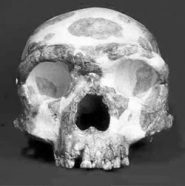Big woman of the distant past
A Stone Age skeleton represents our largest known female ancestor.
By Emily Sohn
If you want to know how tall you’ll be, take a look at your adult relatives. My whole family is small, and I stopped growing at 5 feet 2 inches. My tall friends, on the other hand, have lanky limbs, just like their parents do. Usually, they have grandparents and great-grandparents who were tall, too.
Looking much farther back in time, a new analysis of a Stone Age skeleton reveals the largest female ancestor ever discovered. Her size says a lot about the conditions under which she lived 260,000 years ago, say researchers from of the University of Delaware, Peking University, and Johns Hopkins University School of Medicine.
The skeleton’s bones also give insights into the changes that our ancestors have undergone over many thousands of years.
 |
|
A new analysis of a partial Stone Age skeleton, including this skull, identifies it as coming from the biggest known female among human ancestors.
|
| Karen Rosenberg/Proceedings of the National Academy of Sciences |
Scientists discovered the skeleton 22 years ago in northwest China. Called the Jinniushan specimen, the extensive remains include a skull with lots of teeth on its upper jaw, six vertebrae (spine bones), two left ribs, a left-forearm bone, and the left half of the pelvis.
 |
|
The left arm bone of the biggest known female among human ancestors.
|
| Karen Rosenberg/Proceedings of the National Academy of Sciences |
Some researchers had previously proposed that the Jinniushan specimen was male because it had a large, thick-boned skull. The shape of the pelvis, however, indicates that the skeleton belonged to a female, according to the new analysis.
The woman was about 5 feet, 5-1/2 inches tall and weighed 173 pounds. This may not sound overly large by today’s standards. However, the largest Stone Age female known before this discovery weighed 163 pounds. Her skeleton had come from a 100,000-year-old Neandertal site in France. No others have even come close.
Like modern humans (called Homo sapiens), the Jinniushan woman was in the Homo genus. Her species is still unknown.
Her build—a large, wide body with short arms and legs—was probably an adaptation for surviving in a cold climate, the scientists say. Native people who live in Arctic regions today have similar shapes, which are good for keeping in body heat.
People who lived during the middle of the Stone Age, like the Jinniushan woman, may have been especially in need of a physical buffer against cold weather, the scientists say, because they probably lacked good shelters, clothes, and warm stone hearths.—E. Sohn
Going Deeper:
Bower, Bruce. 2006. Big woman with a distant past: Stone Age gal embodies humanity’s cold shifts. Science News 169(Feb. 25):116. Available at http://www.sciencenews.org/articles/20060225/fob3.asp .







